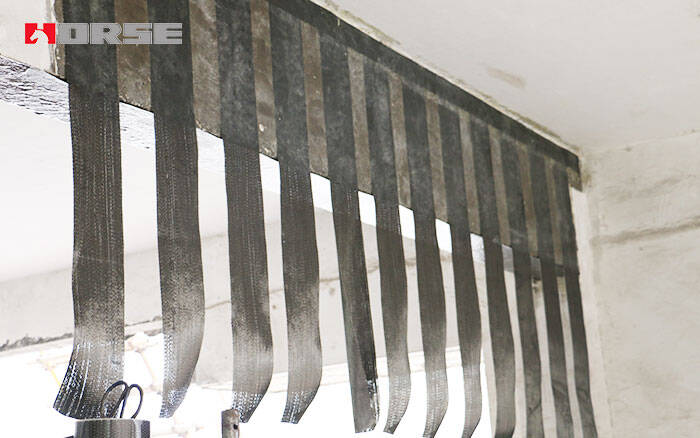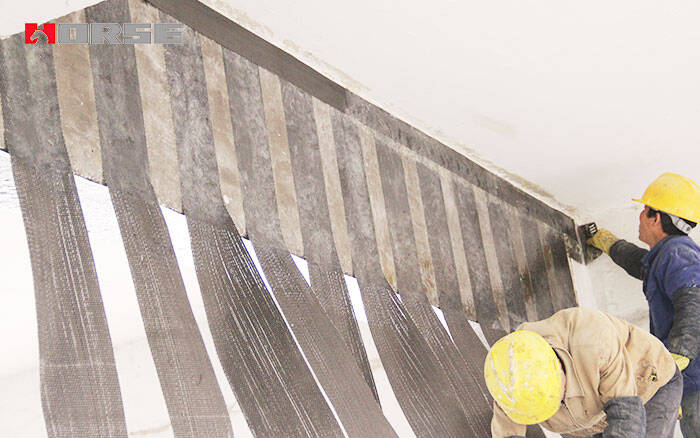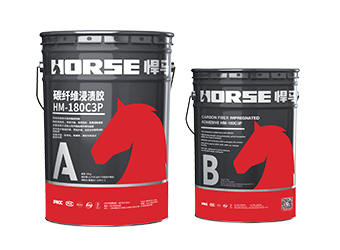Solutions
Horse Construction offers full range of structural strengthening materials with technical supports, documentation supports, products supports, project supports.
Carbon fiber reinforcement technology can restore and improve the bearing capacity and traffic capacity of the old structure, prolong the service life of the structure, meet the needs of follow-up use, not only eliminate the hidden dangers of structural safety, consolidate the use of functions, but also save a lot of investment, and can receive good social and economic benefits.

Externally bonding carbon fiber reinforcement technology is a new type of structural reinforcement technology. Carbon fiber (CFRP) is a kind of structural reinforced composite sheet, which is made of high tensile strength carbon fiber impregnated with epoxy resin. It uses epoxy resin as a binder and sticks to the damaged member along the direction of force or perpendicular to the direction of crack. As the shear bonding medium between them, binder forms a new complex, which makes the reinforcement patch and the existing reinforcement force together, increases the tensile or shear resistance of the structure, effectively improves the strength, stiffness, crack resistance and ductility of the structure, and controls the continuous development of cracks and deflection.
1 Comparison of properties of different materials
The different reinforcement materials used in the analysis project are undoubtedly FRP materials, especially the cloth made of CFRP fabrics, which have superior performance and use.
1) light weight and can operate in narrow space.
2) high strength, flexibly apply bending, close hoop and shear reinforcement.
3) flexible, complex components.
4) chemical corrosion and harsh environment such as alkali resistance;
5) the fabric is flat and has little influence on decoration.
6) long storage life and long operation period.
7) environmental moisture is allowed before, during and after operation.
8) high strength, high modulus binder.
9) its base material can be concrete, masonry, wood structure and other building materials.
10) high temperature resistance, corrosion resistance and good seismic performance.
11) creep resistance under permanent load;
12) thixotropic and easily soluble, which meet the requirements of environmental protection. The quantitative comparison of various materials is shown in Table 1.
| Physical properties | Carbon fiber | Ordinary grade two steel | Finishing bar | steel strand | Carbon steel wire |
| Tensile strength(Mpa) | 3450-3500 | 340 | 835-1000 | 1440 | 1520 |
| Modulus of elasticity(Mpa) | 215-234 | 200 | 210 | 190 | 200 |
| Density(g/cm3) | 1.88 | 7.388 | 7.88 | 7.88 | 7.88 |
Elongation(%) | 1.5 | 10 | 7-10 | 4 | 4 |
Compared with other reinforcement materials, CFRP has higher elastic modulus, higher tensile elasticity and smaller specific gravity.
2 Comparison of economy and efficiency
The one-time investment of CFRP reinforcement can reduce the basic maintenance work by at least 1/2 compared with other reinforcement methods, and the maintenance cycle can be greatly prolonged, thus greatly reducing the maintenance cost. Durability and corrosion resistance are important indexes for evaluating the quality of a structural engineering. Especially for some buildings with special requirements, such as coastal buildings, buildings which are often eroded by adverse chemical environment (chemical plants) and some buildings which are eroded by radiation (nuclear power plant buildings and nuclear waste storage containers), anti-corrosion and anti-radiation (anti-aging) become important considerations in such structural design. Therefore, we are very concerned about the durability of carbon fiber materials and their composites.
As carbon fiber is a kind of high-tech material, it has been used in the field of civil engineering for a short time, and the measured data are very few. However, carbon fiber raw materials have excellent durability. The durability test results and related experimental studies of carbon fiber cloth and its composites in Japan also prove the following viewpoints. In weak acid environment, after a certain number of freeze-thaw cycles, after a certain number of dry-wet alternation, after a certain light time, immersed in 70 C water for 30 days, the bond between CFRP and concrete has no decrease, and the durability is very good. After 100 thermal cycles (+20 20 C), the bearing capacity of CFRP has not decreased. Field observations (including 168 hours of continuous strain observations) and test results of a bridge strengthened with CFRP sheets in Japan show that the bond strength between CFRP sheets and concrete has not decreased, and is greater than the tensile strength of concrete itself, and the bearing capacity has not decreased.
Carbon fiber cloth and its composite with bonding material have good corrosion resistance under various environmental conditions, and can resist acid, alkali, salt and atmospheric corrosion often encountered in buildings. It also has good fatigue resistance. CFRP itself can play a protective role to the internal concrete structure, greatly improving the durability of the concrete structure itself, playing a dual reinforcement and repair role. After the reinforcement is completed, some protective measures can be taken to meet the engineering requirements.

3. The mechanism of CFRP and bonded steel is similar to that of bonded steel. The characteristics and advantages of CFRP and bonded steel are shown in the table.
Reinforcement method | Steel plate reinforced | CFRP reinforced |
Strengthening mechanism | Both of them are basically the same. Both of them use resin bonding materials to paste reinforcement materials on the surface of concrete to achieve the purpose of strengthening structural members. | |
Properties of reinforcement materials | Steel 3: Tensile strength: 210 MPa Modulus of elasticity: 2.1 x 105MPa Isotropy | Tensile strength: 2000 MPa~3 550 MPa Elastic modulus: 2.35 x 105MPa Unidirectional pull |
Joint working performance with concrete | The bond is not sufficient by means of a structural adhesive and anchored by bolts. | Three kinds of bonding materials: 1) resin immersed in the surface layer of concrete; 2) leveling material to repair local unevenness; 3) resin immersed from the fiber between the infiltration of fiber bundles fully wrapped into a composite whole, good working performance together. |
Influence on original structure | The thickness of the first layer is 3 mm~6 mm, and the quality of each layer is 23.7 kg/m2~47.2 kg/m2. | The thickness of the first layer is 0.5 mm~0.6 mm, and the quality of each layer is 500 g/m2~600 g/m2. |
Construction efficiency | If the steel plate is cut in advance, it will be difficult to cut the material in irregular size, so it is difficult to match the actual structure. Because of its large stiffness, the effective bonding area is difficult to reach the level that carbon fiber can be pasted, and it is difficult to remedy the cavity. It is necessary to clamp holes or clamps to glue. | It can be cut on the spot according to the actual size, and can be used for irregular shape reinforcement. No need for large machinery, light and soft, easy to attach. Effective bonding area can reach more than 95%. |
Applicable | It only applies to simple structural types. | It is widely applied to reinforcement and repair of various structural types, various structural shapes including curved surface and complex nodes. |
Durability | For outdoor long-span structures, the thermal conduction rate of steel plate and concrete is more than 30 times different, and the deformation of steel plate and concrete is not synchronous under the action of temperature, which leads to the failure of bonding layer. The steel plate itself is easy to rust and needs regular maintenance. | Carbon fiber materials have excellent durability, and are resistant to acid, alkali, salt, atmospheric and environmental corrosion. |
Time limit | Longer | Short, 1/2 of bonded steel reinforcement. |
Maintenance costs | Later maintenance costs are higher | Later maintenance costs are low. |
5 Conclusion
Carbon fiber reinforcement technology can restore and improve the bearing capacity and traffic capacity of the old structure, prolong the service life of the structure, meet the needs of follow-up use, not only eliminate the hidden dangers of structural safety, consolidate the use of functions, but also save a lot of investment, and can receive good social and economic benefits.
You can find anything here you are in need of, have a trust trying on these products, you will find the big difference after that.

High strength, unidirectional carbon fiber wrap pre-saturated to form a carbon fiber reinforced polymer (CFRP) wrap used to strengthen structural concrete elements.

Good impregnation carbon fiber adhesive for applying carbon fiber reinforced polymer(CFRP) wrap for structural strengthening

High strength carbon fiber reinforced polymer (CFRP) strip / laminate / plate for structural strengthening and concrete repair